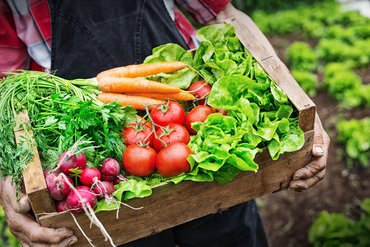The U.S. Department of Agriculture is investing $69 million to address the food and nutrition security needs of low income communities enduring the pandemic, enhance the resilience of food and healthcare systems impacted by the pandemic, and maximize the funds reaching participants.
Twenty awards totaling $61.5 million are for Nutrition Incentive Grants, and 15 awards totaling $7.5 million are for Produce Prescription Grants. These are part of the National Institute of Food and Agriculture’s Gus Schumacher Nutrition Incentive Program COVID Relief and Response grants program.
Examples of organizations receiving funding from Nutrition Incentive Grants include Wholesome Wave Georgia for its “Georgia Fresh for Less” program; The Food Basket, Inc., Hawai’i Island’s Food Bank for “DA BUX Double Up Food Bucks” program; and the Fair Food Network in Michigan for its "Double Up Food Bucks" program.
Examples of organizations receiving Produce Prescription Grants include Fresh Approach of Concord, California; Mountain Comprehensive Health Corporation of Whitesburg, Kentucky, for its “MCHC FARMACY” program; and the Community Outreach and Patient Empowerment Program, Inc., of Gallup, New Mexico, for its “Navajo Fruit and Vegetable Prescription Program.”
“Bolstering nutrition security is one of our top goals in this Administration,” said Agriculture Secretary Tom Vilsack, in a statement. “The awards we are announcing today will help households in communities across the country – many hard-hit by the pandemic and the resulting economic challenges – be better equipped to purchase healthy fruits and vegetables. The organizations receiving this funding have demonstrated their ability to support vulnerable Americans with timely and impactful relief during this ongoing crisis.”
In addition, the USDA has released a re-evaluation of the Thrifty Food Plan, used to calculate Supplemental Nutrition Assistance Program benefits. The reevaluation concluded that the cost of a nutritious, practical, cost effective diet is 21 percent higher than the current Thrifty Food Plan. As a result, the average SNAP benefit, excluding additional funds provided as part of pandemic relief, will increase by $36.24 per person, per month, or $1.19 per day, for Fiscal Year 2022 beginning on October 1, 2021.
“To set SNAP families up for success, we need a Thrifty Food Plan that supports current dietary guidance on a budget,” said Stacy Dean, deputy undersecretary for food, nutrition, and consumer services, in a statement. “Too many of our fellow Americans struggle to afford healthy meals. The revised plan is one step toward getting them the support they need to feed their families.”
Related: USDA to Spend $4 Billion to Strengthen Supply Chain; Biden Administration to Spend $1 Billion on Food Sourcing.

